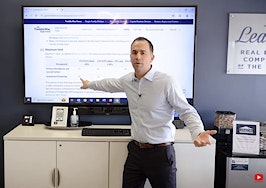The departure of the Blackstone Group from the single-family rental business in November marked the end of an era.
Blackstone was the largest and the last of the original Wall Street investment firms that entered the SFR business eight years ago, in the wake of the devastating tsunami of foreclosures was sinking home values and creating a rare opportunity to buy thousands of homes at fire-sale prices.
Much has changed at the top of the single-family rental business. As home values improved and foreclosures dried up, the original business model based on cheap acquisitions has evolved. Many of the early entrants could not weather the change, and they sold out or were acquired.
Rising rents fueled by extraordinary demand from the millennial generation has made single-family rental business even more attractive to institutional investors than it was eight years ago. Survivors who weathered the transition and new entrants attracted by a booming real estate economy are finding new ways to find properties and serve a massive generation of young families, many of whom are trapped in rentals by home prices they cannot afford.
Advances in management services make it possible for the largest investors to oversee thousands of geographically dispersed properties. Once limited to 30 or 40 properties, now property managers can service thousands of single-family homes at scale.
Institutional investors — those who purchased more than 101 homes — nearly doubled their activity between 2000 and 2013 but have pulled back since the foreclosure crisis and now sit at 15.8 percent of home purchases, according to CoreLogic.
Yet these institutional investors still own a tiny share — about 2 percent — of single-family rentals. “Mom-and-pop” investors (who own fewer than 10 properties) own nearly 90 percent of the nation’s 18 million single-family rentals.

Mom-and-pop investors dominate single-family rentals. Source: Freddie Mac
“In 2018, the investment rate in the U.S. housing market reached 11.3 percent of all purchases — the highest rate since CoreLogic started tracking these data in 1999. The investment purchase rate in 2017 was the second highest on record at 11 percent, which was above the investor buying fury of 2012 to 2014 when purchase rates reached 10.3-10.9 percent,” according to the CoreLogic report.
Nevertheless, institutional investors are experiencing somewhat of a renaissance. Some 19 million millennials who want to own a home are renting because they don’t think they can afford a down payment. Thousands of them are discovering single-family rentals. SFRs provide most of the things a young family needs — space, a location in a good school district, a washer and dryer, a backyard, and a lifestyle that is just like owning without a mortgage: A large percentage of them may never buy.
Vacancy rates are stable at about four percent, and rents are continuing to rise in step with home prices because demand is strong.
Growing pains
Atlanta’s market share of institutional investor-owned SFRs is over 15 percent, twice the size of any other metro. Fulton County is Georgia’s largest county, home to downtown Atlanta and more than a million people, 16 percent of whom have incomes below the poverty level.
Georgia’s eviction laws are very landlord-friendly, and, in 2017, 40,000 people — 1 in 5 renters — were evicted in Fulton County. More than a third of the 1 million evictions filed in Atlanta’s five counties since 2010 were “serial filings” (filings made within a year of one another at the same property) against a tenant with the same name. Since 2010, more than 70,000 cases in Atlanta were serial filings.
In 2016, the Federal Reserve Bank of Atlanta conducted a study of Fulton County’s high eviction rates in 2015 and found that large landlords are 8 percent more likely than small landlords to file eviction notices. Moreover, private equity investors have very different eviction rates. One was as high as one-third of all its holdings, and several firms’ eviction rates did not differ from smaller landlords.
The Atlanta Fed study provided empirical evidence that large investor size is correlated with higher levels of housing instability. It also found that companies can reduce the housing instability they cause by not using serial evictions. It is cited often by critics and journalists, as in Prashant Gopal’s 2017 Bloomberg piece, “Wall Street America’s New Landlords Kick Tenants to the Curb.”
“Our business is keeping tenants in their homes however that we can do that. It is always in the best interest for companies to be responsive,” notes David Howard, executive director of the National Home Rental Council, a trade association that represents larger investors in a phone interview. “A number of our members are rated by the Better Business Bureau, and they look at things like responsiveness to complaints. Many of our members have A ratings by the Better Business Bureau.”
New sources of inventory
With prices still rising and the inventory shortage still making it hard to find houses, where will Howard’s members find the properties they will need to meet this demand?
Two new sources are in the development stages. Institutional investors are building communities of single-family rentals (see “Why built-to-rent homes are booming.”) After becoming a source for builders to sell their excess inventory, some large investors are going into the business of building built-to-rent properties, either in partnership with a local builder or by creating in-house construction capabilities.
The primary source of single-family rental homes is still the existing housing stock, and iBuyers have become an increasingly popular source of acquisitions for institutional invests.
In a November 2018 report, Attom Data Solutions reported that three institutional investors bought 1 in 10 homes sold by Opendoor and Offerpad that year. That was 9.6 percent of all sales by those two iBuyers combined, up from a six percent share in 2017.
Though institutional investors will (hopefully) never see again the bargains that sold them on single-family rentals eight years ago, those who have stuck it out for this long have figured out how to make money in good times and bad.

iBuyer Sales To Institutional Investors Increasing. Source: ATTOM Data Solutions
Steve Cook is a communications consultant and editor of Real Estate Economy Watch.













